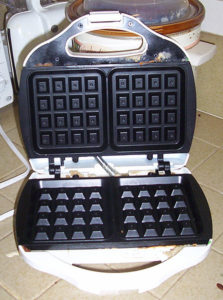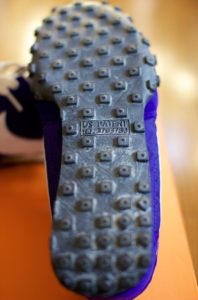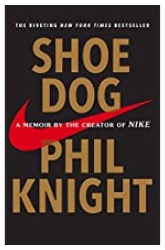I have heard the story of the birth of Nike told a number of times, but until I read Shoe Dog, I didn’t really understand the story. The story was not in context and it was thereby distorted.
Here is the story I heard:
One day the founder of Nike was making breakfast. He looked at his waffle Iron, realized that that pattern would be perfect for running shoes, poured rubber into the waffle iron, and out came the first Nikes. He started a shoe company and he was immediately successful. He is now a multi-millionaire.
Here is the reality of the story.
In 1962, Phil Knight traveled to Japan and struck a deal with Onitsuka Co. to import Tiger running shoes. He spent nearly all of 1963 waiting for the shoes to arrive. In the mean time, he took a few additional college credits so he could work as an accountant.
He was working as a CPA to support himself when the shoes finally arrived in December. He sent a few pairs to his former track coach at the University of Oregon, Bill Bowerman. Bowerman immediately saw the potential in the Tiger running shoes and he became Knight’s partner in the business.
Bowerman had spent most of his life obsessing over how to make his runners faster. According to knight,
In the four years I’d run for him at Oregon, Bowerman was constantly sneaking into our lockers and stealing our footwear. He’d spend days tearing them apart, stitching them back up, then hand them back with some minor modification, which made us either run like deer or bleed. Regardless of the results, he never stopped. He was determined to find new ways of bolstering the instep, cushioning the midsole, building out more room for the forefoot. He always had some new design, some new scheme to make our shoes sleeker, softer, lighter. Especially lighter. One ounce sliced off a pair of shoes, he said, is equivalent to 55 pounds over one mile. He wasn’t kidding. His math was solid. You take the average man’s stride of six feet, spread it out over a mile (5,280 feet), you get 880 steps. Remove one ounce from each step—that’s 55 pounds on the button. Lightness, Bowerman believed, directly translated to less burden, which meant more energy, which meant more speed. And speed equaled winning. Bowerman didn’t like to lose. (I got it from him.) Thus lightness was his constant goal.
Goal is putting it kindly. In quest of lightness he was willing to try anything. Animal, vegetable, mineral, any material was eligible if it might improve on the standard shoe leather of the day. That sometimes meant kangaroo skin. Other times, cod. You haven’t lived until you’ve competed against the fastest runners in the world wearing shoes made of cod.[1]
Bowerman had improved some of the Tiger running shoes by providing Onitsuka with new shoe designs. Before the 1968 Olympics in Mexico City, he designed running shoes called the Cortez. They were a run-away success (no pun intended).
Bowerman had also experimented with nutritional sports drinks (before Gatorade was invented). He was an early pioneer in the use of rubberized tracks. Knight recorded:
In his “free time,” he liked to noodle with the surface at Hayward Field. Hayward was hallowed ground, steeped in tradition, but Bowerman didn’t believe in letting tradition slow you down. Whenever rain fell, which it did all the time in Eugene, Hayward’s cinder lanes turned to Venetian canals. Bowerman thought something rubbery would be easier to dry, sweep, and clean. He also thought something rubbery might be more forgiving on his runners’ feet. So he bought a cement mixer, filled it with old shredded tires and assorted chemicals, and spent hours searching for just the right consistency and texture. More than once he made himself violently sick from inhaling the fumes of this witches’ brew. Blinding headaches, a pronounced limp, loss of vision—these were a few of the lasting costs of his perfectionism.[2]

So it should not be surprising then that it was Bowerman who spotted the waffle iron, “carried the waffle iron out to the garage, filled it with urethane, heated it up—and promptly ruined it. The urethane sealed it shut, because Bowerman hadn’t added a chemical releasing agent.”[3] But he bought a new waffle iron. That mold broke. So he designed his own waffle pattern out of a sheet of stainless steel. It worked. He “sewed to the sole of a pair of running shoes. He gave these to one of his runners. The runner laced them on and ran like a rabbit.”[4]
It was 1971—nine years after Knight had gone to Japan to meet with Onitsuka. Knight and his team had sold a lot of Tiger running shoes over the previous decade. They also began selling their own athletic shoes—Nikes. This was not Nike’s first shoe and it did not launch the company, but the waffle trainer became a hit—they had built a better mousetrap, and it would propel their success.
The point of the lesson is that success usually takes time. Bowerman spent his career focused on making runners faster. The waffle trainer was just one step in a much longer race.
It has been said that it takes 20 years to become an “overnight success.” Rarely does a person magically stumble over the great secret unless he has been totally focused on one major objective.
There is a saying, falsely attributed to Thomas Jefferson, that illustrates this concept: “I am a great believer in luck, and I find the harder I work, the more I have of it.” [5] While Jefferson didn’t say it, the logic is sound. The more focused you are on your aim, the more likely you are to see things you have not seen before–like the waffle pattern as an innovation for the sole of a running shoe.

What about you?
Have you been focused on one major objective? What have you been doing in the past that will lead you to see the next innovation?
References
[1] Knight, P. (2016). Shoe Dog: A memoir from the creator of Nike. New York: Scribner. (p. 44)
[2] Knight, P. (2016). Shoe Dog: A memoir from the creator of Nike. New York: Scribner. (pp. 87-88).
[3] Knight, P. (2016). Shoe Dog: A memoir from the creator of Nike. New York: Scribner. (p. 196).
[4] Knight, P. (2016). Shoe Dog: A memoir from the creator of Nike. New York: Scribner. (p. 197)
[5] I am a great believer in luck…(n.d.). Monticello.org. Retrieved from https://www.monticello.org/site/research-and-collections/i-am-great-believer-luckspurious-quotation
___________

Dr. Darin Gerdes is a tenured Professor of Management in the College of Business at Charleston Southern University.
All ideas expressed on www.daringerdes.com are his own.
This post was originally created for Great Business Networking (GBN), a networking organization for business professionals where Dr. Gerdes is the Director of Education.
___________

